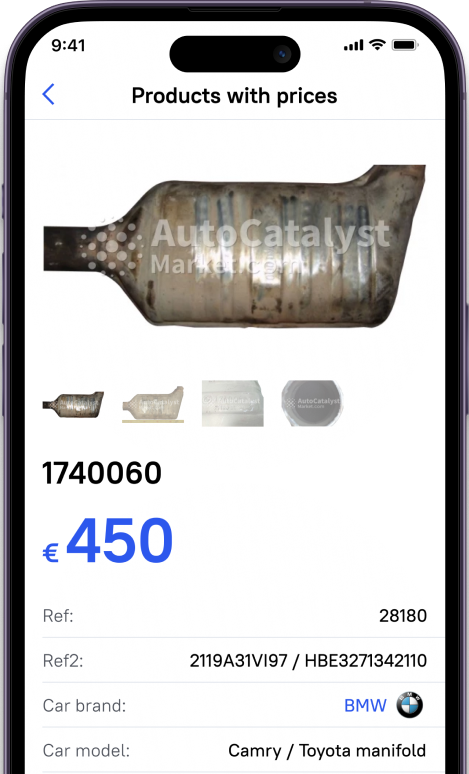- Types of catalyst location
- 1. A catalyst as a part of a muffler
- 2. Catalyst next to the exhaust manifold
- 3. Catalyst is connected to a muffler
- 4. Catalyst sensors
- Why it is better to leave the catalyst where it is?
Learning more about cars and spare parts, one may face names and terms, which can seem new or even unknown. A catalytic converter in a vehicle or a car catalyst is an important part of the whole exhaust system. Its role is to serve to reduce the emission of harmful combustion products into the atmosphere. Talking about chemistry, the term catalyst is described as a substance, which can accelerate or cause a chemical reaction without participation in such a complex reaction itself. It is guaranteed by such substances as copper, nickel, gold, palladium, rhodium, chromium. The principle of operation of a car catalyst is precisely based on the ability of substances to accelerate the reaction. Most often, it is located immediately after the front pipe, but sometimes it is installed directly on a front pipe. They do this for faster warming up since it works effectively only at temperatures above 300 ° C.
If you check exhaust gases that come out of a crankcase of the engine of any car, you can observe a fairly high level of concentration of harmful chemical compounds that enter the environment and pollute it. It is to combat such emissions that a catalytic converter, or as it is also called, a car catalyst, was invented and designed. The main task of a catalyst is to oxidize hazardous harmful compounds, turning them into relatively safe for the environment. That Is why its presence in all vehicles is essential for health and nature.
Nowadays it is difficult to imagine any modern car, the exhaust system of which is not equipped with a catalyst even from an assembly line. Some people still do not imagine where it is located and how to find it by yourself. There are several ways to detect this car part if you know where to look. The catalytic car part is not that small to be lost, because its function is to reduce air pollution.
Types of catalyst location
1. A catalyst as a part of a muffler
It should be noted that the catalyst should be looked for in a muffler. It is designed to clean the exhaust, and therefore it is ALWAYS located at the beginning of a car muffler, where hot, often unburned gases come out. This catalyst is called upon to burn and clean gas, for this, it has a special mesh - a honeycomb structure, which is often made using noble metals.
2. Catalyst next to the exhaust manifold
In 70% of cases, a simple and useful catalyst is located just behind an exhaust manifold, in the engine compartment of a car. That is, gases are collected from all 4 cylinders and enter the catalyst for cleaning. You will not confuse it with any muffler knee. The thing is that this is a thick "cistern", surpassing other parts in size.
3. Catalyst is connected to a muffler
Such amount was dictated by the experience of operating cars. Previously, a common converter was often attached under the bottom of a car, that is, not in the engine compartment, but under the bottom. However, protruding a large tank, the catalyst was simply cut off! This item is not cheap, it's not just a pipe or a resonator. Therefore, now almost all manufacturers are switching to fastening catalyst just next to the collector, it is more practical. Although, it is worth noting that some manufacturers still install catalysts under the bottom of a car. This is due to a narrow engine compartment.
If you open the hood, then you will not always be able to determine its location. Often the catalyst is covered with a protective metal casing so that there is just a sheet on top and catalyst is already under it. If you lift the car on lifts or drive into a hole, it is much easier to see it.
4. Catalyst sensors
Where are the sensors? Many people think that catalyst sensors are screwed into it! But this is wrong. There should not be sensors in a catalyst. But before and after the catalyst, two oxygen sensors are installed. The task is not only to measure the oxygen content before and after the catalyst but also to see excessive fuel consumption in a system. According to data from these sensors, the work of fuel supply can be automatically adjusted to avoid overflows.
Also, sensors signal catalyst failure. If the data before and after catalytic converter does not differ much, this indicates that cleaning does not occur - perhaps "honeycomb" has collapsed or melted. This is where CHECK ENGINE error comes out.
Why it is better to leave the catalyst where it is?
There are plenty of pros and cons for a catalyst here! Of negative aspects, one can be named: exhaust will come out directly without purification, and this is bad for the environment because every year environmental background only gets worse. Also, you will not pass control as catalyst measures CO emissions from the muffler. And if you remove this important car part from the system, then you need to flash the ECU, because oxygen sensors will just go crazy.
Do not try to change the structure of your vehicle or its parts. Every item Is created for its purpose, calculated by professional and experienced engineers. Just take care of your car and keep it clean and fresh day after day. This will guarantee a long and happy life for both the car owner and the vehicle.












































